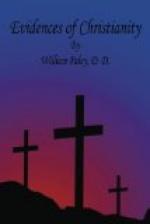4. The admonitions* which Christ is represented to have given to his followers to save themselves by flight are not easily accounted for on the supposition of the prophecy being fabricated after the event. Either the Christians, when the siege approached, did make their escape from Jerusalem, or they did not: if they did, they must have had the prophecy amongst them: if they did not know of any such prediction at the time of the siege, if they did not take notice of any such warning, it was an improbable fiction, in a writer publishing his work near to that time (which, on any, even the lowest and most disadvantageous supposition, was the case with the gospels now in our hands), and addressing his work to Jews and to Jewish converts (which Matthew certainly did), to state that the followers of Christ had received admonition of which they made no use when the occasion arrived, and of which experience then recent proved that those who were most concerned to know and regard them were ignorant or negligent. Even if the prophecies came to the hands of the evangelists through no better vehicle than tradition, it must have been by a tradition which subsisted prior to the event. And to suppose that without any authority whatever, without so much as even any tradition to guide them, they had forged these passages, is to impute to them a degree of fraud and imposture from every appearance of which their compositions are as far removed as possible.
_________
* “When ye shall see Jerusalem compassed with armies, then know that the desolation thereof is nigh; then let them which are in Judea flee to the mountains; then let them which are in the midst of it depart out, and let not them that are in the countries enter thereinto.”—Luke xxi. 20, 21. “When ye shall see Jerusalem compassed with armies, then let them which be in Judea flee unto the mountains; let him which is on the house-top not come down to take anything out of his house; neither let him which is in the field return back to take his clothes.”—Matt. xiv. 18. _________
5. I think that, if the prophecies had been composed after the event, there would have been more specification. The names or descriptions of the enemy, the general, the emperor, would have been found in them. The designation of the time would have been more determinate. And I am fortified in this opinion by observing that the counterfeited prophecies of the Sibylline oracles, of the twelve patriarchs, and, I am inclined to believe, most others of the kind, are mere transcripts of the history, moulded into a prophetic form.
It is objected that the prophecy of the destruction of Jerusalem is mixed or connected with expressions which relate to the final judgment of the world; and so connected as to lead an ordinary reader to expect that these two events would not be far distant from each other. To which I answer, that the objection does not concern our present argument. If our Saviour actually foretold the destruction of Jerusalem, it is sufficient; even although we should allow that the narration of the prophecy had combined what had been said by him on kindred subjects, without accurately preserving the order, or always noticing the transition of the discourse.




